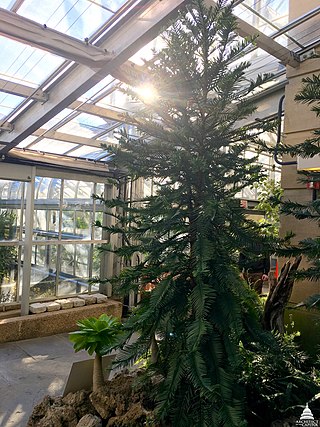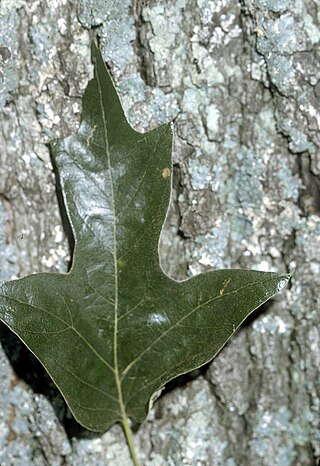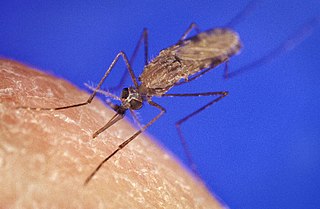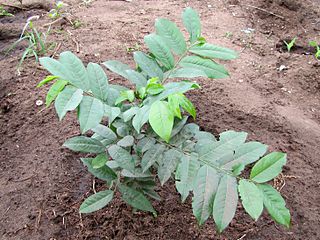
Wollemia is a genus of coniferous trees in the family Araucariaceae, endemic to Australia. It represents only one of three living genera in the family, alongside Araucaria and Agathis. The genus only has a single known species, Wollemia nobilis which was discovered in 1994 in a temperate rainforest wilderness area of the Wollemi National Park in New South Wales. It was growing in a remote series of narrow, steep-sided, sandstone gorges 150 km (93 mi) north-west of Sydney. The genus is named after the National Park.

Quercus petraea, commonly known as the sessile oak, Cornish oak, Irish Oak or durmast oak, is a species of oak tree native to most of Europe and into Anatolia and Iran. The sessile oak is the national tree of Ireland, and an unofficial emblem in Wales and Cornwall.

Laurus nobilis is an aromatic evergreen tree or large shrub with green, glabrous (smooth) leaves. It is in the flowering plant family Lauraceae. It is native to the Mediterranean region and is used as bay leaf for seasoning in cooking. Its common names include bay tree, bay laurel, sweet bay, true laurel, Grecian laurel, or simply laurel. Laurus nobilis figures prominently in classical Greco-Roman culture.

Quercus falcata, also called southern red oak, spanish oak, bottomland red oak or three-lobed red oak is an oak. Native to the southeastern United States, it gets its name the "Spanish Oak" as these are the areas of early Spanish colonies, whilst "southern red oak" comes from both its range and leaf color during late summer and fall. The southern red oak is a deciduous angiosperm, so has leaves that die after each growing period and come back in the next period of growth.

The Anopheles gambiae complex consists of at least seven morphologically indistinguishable species of mosquitoes in the genus Anopheles. The complex was recognised in the 1960s and includes the most important vectors of malaria in sub-Saharan Africa, particularly of the most dangerous malaria parasite, Plasmodium falciparum. It is one of the most efficient malaria vectors known. The An. gambiae mosquito additionally transmits Wuchereria bancrofti which causes lymphatic filariasis, a symptom of which is elephantiasis.

Anemone hepatica, the common hepatica, liverwort, liverleaf, kidneywort, or pennywort, is a species of flowering plant in the buttercup family Ranunculaceae, native to woodland in temperate regions of the Northern Hemisphere. This herbaceous perennial grows from a rhizome.

Mkilua is a genus of plant in the family Annonaceae. It is native to Kenya and Tanzania. It contains a single species, Mkilua fragrans. Bernard Verdcourt, the British botanist who first formally described the species, named it after the fragrance of its flowers which smell like lemon. It is commonly called Mkilua Mwitu, Kilua and Kiluwa in Swahili, and Kingade in Digo. Volatile oils extracted from its leaves, flowers, and aerial parts have been reported to be repellent to Anopheles gambiae mosquitoes which are vectors for the malaria parasite Plasmodium falciparum. Bioactive molecules extracted from its roots have been reported to have antimicrobial activity in tests with Streptococcus agalactiae and Staphylococcus aureus.
Vepris lecomteana, synonym Oricia lecomteana, is a species of plant in the family Rutaceae. It is found in Cameroon, the Republic of the Congo, Gabon and Nigeria. Its natural habitat is subtropical or tropical moist lowland forests. It is threatened by habitat loss.
Vepris suaveolens, synonym Oricia suaveolens, is a species of plant in the family Rutaceae. It is found in Cameroon, the Central African Republic, the Democratic Republic of the Congo, Ivory Coast, Ghana, Guinea, Liberia, Nigeria, and Sierra Leone. It is threatened by habitat loss.
Vepris glaberrima, synonym Oriciopsis glaberrima, is a species of plant in the family Rutaceae. It is native to Cameroon, the Central African Republic, the Republic of the Congo and Gabon. It is threatened by habitat loss.
Teclea carpopunctifera is a small forest tree in the family Rutaceae. The genus Teclea has been synonymized with Vepris, but this species appears not to have been given a name in Vepris and is regarded as "unplaced" by Plants of the World Online. It is endemic to Côte d'Ivoire.

Vepris is a genus of plant in family Rutaceae. It comprises around 90 species, mainly from tropical Africa, Madagascar and the Mascarene Islands and at a lesser extent Arabia and India.
Vepris heterophylla is a species of plant in the family Rutaceae. It is found in Burkina Faso, Cameroon, Ghana, and Mali. It is threatened by habitat loss.
Vepris sansibarensis is a species of plant in the family Rutaceae. It is found in Kenya and Tanzania.
Alchornea floribunda is a plant native to tropical Africa. The plant is locally known as Niando.
Sideroxylon salicifolium, commonly called white bully or willow bustic, is a species of flowering plant native to Florida, the West Indies and Central America.

Allocasuarina verticillata, commonly known as drooping sheoak, is a species of flowering plant in the family Casuarinaceae and is endemic to south-eastern Australia. It is a small dioecious tree that has drooping branchlets up to 400 mm (16 in) long, the leaves reduced to scales in whorls of nine to thirteen, the mature fruiting cones 20–50 mm (0.79–1.97 in) long containing winged seeds 7–12 mm (0.28–0.47 in) long.

Allocasuarina littoralis, commonly known as black she-oak, is a species of flowering plant in the family Casuarinaceae and is endemic to eastern Australia. It is dioecious, or less commonly a monoecious tree or shrub, that has its leaves reduced to scales, usually in whorls of six to eight, the mature fruiting cones 10–30 mm (0.39–1.18 in) long containing winged seeds (samaras) 4.0–10 mm (0.16–0.39 in) long.
Asteranthe lutea is a species of plant in the genus Asteranthe. It is native to Tanzania. Kaj Borge Vollesen, the botanist who first formally described the species in 1980, named it after its yellow petals.
Vepris bremekampii, the wart-berry or wild mandarin, is a species of flowering plant in the family Rutaceae, native to southern Mozambique and northern South Africa. An evergreen shrub or small tree reaching 6 m (20 ft), its 1.4 cm (0.6 in) fruit are wrinkled and warty with a resemblance to Citrus.










